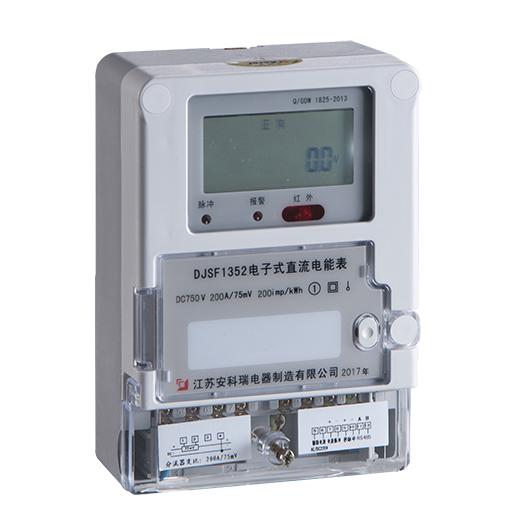With the development of electronic technology, standard electric energy meters have undergone a transformation towards digitization and intelligence. Compared to traditional mechanical energy meters, electronic energy meters have various advantages such as high measurement accuracy, low power consumption, and strong anti-theft capabilities. So, what is the working principle of electronic energy meters? And what functions do they have?
An electronic energy meter utilizes large-scale integrated circuits and digital sampling processing technology. The overall design incorporates multiple anti-interference techniques and is used for time-of-use metering of rated frequency 50Hz AC active energy, which helps to balance the load on the power grid.
The electronic energy meter can have a localized LCD display and features functions such as measuring forward active energy, reverse active energy, and reactive energy. It can store data and use it to set composite active energy. Active energy is accumulated separately for different time periods, including peak, shoulder, flat, and valley energy. It can also have event recording functionality and communication capabilities such as infrared, RS485, power line carrier, and Bluetooth. After a power outage, the LCD display automatically turns off. Within 2 hours of the display turning off, it can be awakened by pressing a button, and each time it stays active for 30 seconds. The DJSF1352 electronic DC energy meter from Acrel, for example, incorporates the aforementioned functions.

An energy meter consists of two main functional parts: the energy measurement part and the microprocessor control part. The energy measurement part of this energy meter uses dedicated large-scale integrated circuits to generate a pulse sequence representing the amount of electricity consumed. These pulses are sent to the microprocessor for energy measurement. Upon receiving the pulse signals, the microprocessor accumulates the number of input pulses and, based on the pulse constant, accurately measures the energy consumed. The data is then transmitted through various interfaces to enable different control functions.
Measuring forward active energy and reverse active energy, storing data, and using it to set composite active energy.
Measuring reactive energy, with the ability to measure reactive energy in all four quadrants. The reactive energy can be set as the sum of any four quadrants and can be combined.
Time-of-use metering: Accumulating and storing active energy for peak, shoulder, flat, and valley time periods, as well as total energy consumption.
The meter should be able to store the total energy consumption and energy consumption for each tariff rate for at least 24 settlement days. The data storage boundary is at the beginning of each month or at the top of each hour from the 1st to the 28th of the month.
If the settlement time is missed during a power outage, the meter should complete the missing settlement day energy consumption data when the power is restored, with a maximum of 12 retroactive completions.
The current energy consumption can be stored with up to 4 decimal places, allowing the energy consumption to increase by the energy represented by a single pulse for each decimal place.
Ability to measure, record, and display operational parameters such as voltage, current (including neutral current), power, and power factor of the energy meter.
Event Recording:
Permanent recording of the time of occurrence and energy consumption data when the energy meter is reset to zero.
Recording the total number of programming times, the most recent 10 programming records, operator codes, and data identifiers for programming items.
Recording the total number of clock setting times (excluding broadcast time calibration), the previous 10 pre-calibration times, post-calibration times, and operator codes.
Recording the total number of broadcast time calibrations, the previous 100 pre-calibration times, post-calibration times, and corresponding energy consumption data.
Recording the most recent 10 power-off events and the most recent 10 power-on events, including the time of occurrence and energy consumption data.
Recording the total number of times the meter cover is opened, the time of occurrence and end of the most recent 10 meter cover opening events, and the corresponding energy consumption data. During a power outage, the energy meter only records the earliest meter cover opening event.
Tariff and Time-of-Use Function:
Up to 12 tariff rates can be set within a day, including peak, shoulder, flat, and valley rates. Within 24 hours, up to 14 time periods can be set, with a minimum time period of 15 minutes. The time periods can span across midnight and should be arranged in chronological order.
The energy meter can have two or more sets of programmable time-of-use tables. Each set can have a maximum of 8 daily time-of-use tables, and the second set of tariff time periods can be activated at specified times.
The energy meter supports setting special tariff time periods for holidays and weekends.
The time-of-use tables can be modified through communication interfaces such as Bluetooth, RS485, and power line carrier.
The daily time-of-use tables can be set according to the actual number of time periods. After a successful setting, the subsequent time periods are completed based on the last time period.
Freezing Function:
Timed freezing: Freezing energy consumption data at predetermined times and intervals. Each freezing record should be saved at least 60 times.
Instantaneous freezing: In abnormal situations, freeze the current calendar, time, energy consumption, and important measurement data. The last 3 instantaneous freezing records should be saved.
Agreed freezing: Freeze the energy consumption and other important data at the moment of tariff/time-of-use conversion or when the power company deems it necessary.
Daily freezing: Store energy consumption data at midnight every day. It can store data for up to 254 days.
Monthly freezing: Store total energy consumption and tariff-specific energy consumption data at midnight on the 1st day of each month. It can store data for up to 24 times.
Hourly freezing: Store active total energy consumption at each hour or half-hour. It can store up to 254 data records.